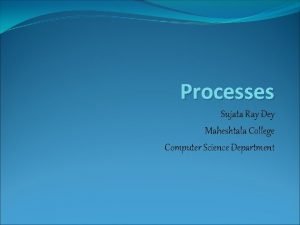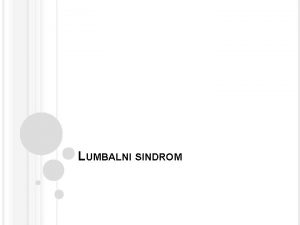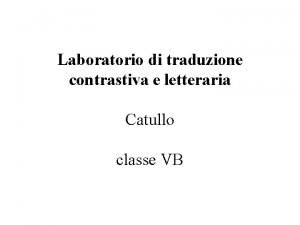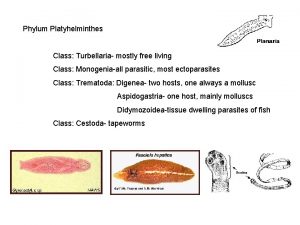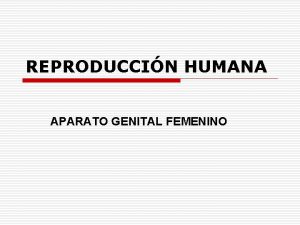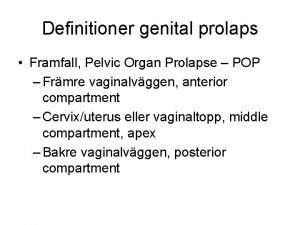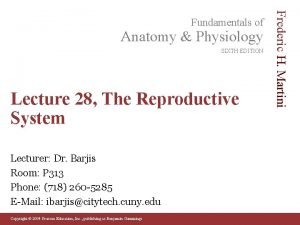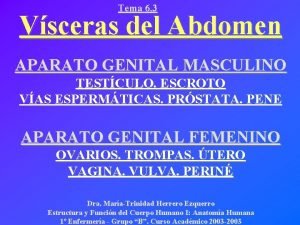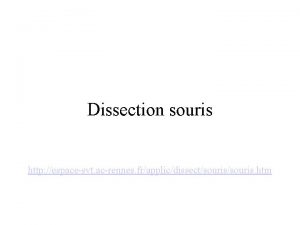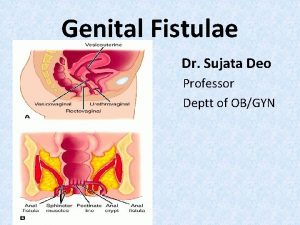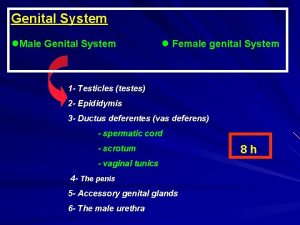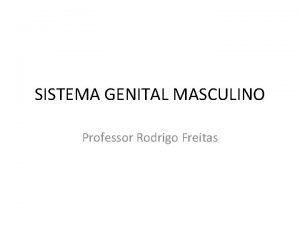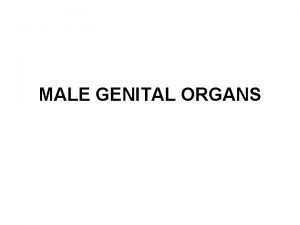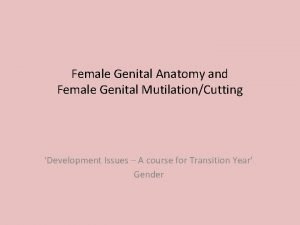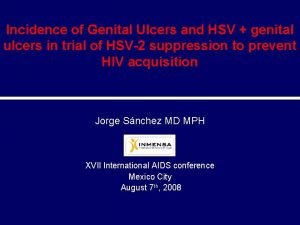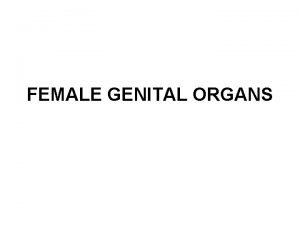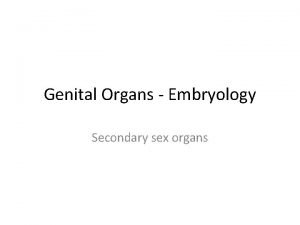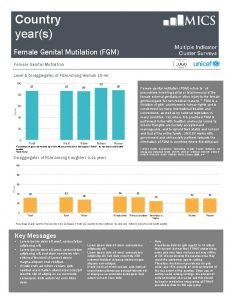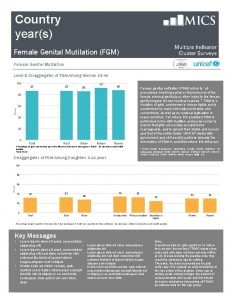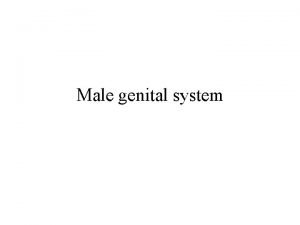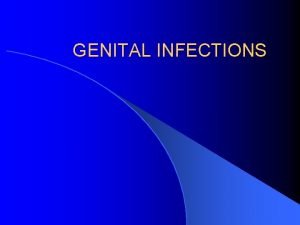Genital Fistulae Dr Sujata Deo Professor Deptt of



































- Slides: 35

Genital Fistulae • Dr. Sujata Deo • • Professor Deptt of OB/GYN

Vesicovaginal Fistula





• Obstetrical • Gynaecological Causes 1. Obstetrical causes – Ishemic: Due to prolonged compression effect on the bladder base between the head and pubic symphysis eg : obstructed labour Traumatic : Instrumental vaginal delivery – in destructive operation, forcep delivery • Abdominal operation – Hysterectomy for rupture uterus , LSCS

Gynaecological causes • Operative Injury – Ant. Colporraphy , Abdominal hysterectomy • Traumatic - ant. Vaginal wall & bladder may be injured following fall on a pointed objects, by a stick used for criminal abortion • Malignancy – by direct spread in cases of Advanced ca of cervix, vagina or bladder • Radiation - Due to radiation effect ishemic necrosis may occur

Types • Simple - Healthy tissues with good acces • Complicated – Tissue loss, scarring, difficult access associated with RVF Depanding upon SITE of the Fistula – Juxtracervical : ( close to cx) –communication between supratrigonal region of bladder and vagina Midvaginal : communication between base(Trigone) of bladder and vagina Juxtraurethral: communication between neck of bladder and vagina






Management • Prophylaxis • Immediate management– once the diagnosis is made , continous catherization for 6 -8 is maintained. • Operative – surgery is choice preoperative assessment preoperative preperations


Definitive Surgery • Ideal time for surgery is after 3 months following delivery • Surgical Fistula– If recogniged <24 hrs: immediate repair If recogniged >24 hrs : repair after 3 months Radiation Fistula : repair after 12 months








Rectovaginal Fistula

Definition Abnormal communication between the rectum andvagina with involuntry escape of flatus and or feces into vagina is called RVF

Causes 1 -Acquired 2 - Congenital Acquired – Obstatrical causes – • Incomplete healing or unrepaired recent complete perineal tear is commonest • Obstructed labour- During obstructed labour the compression effect produces necrosis →infection→ sloughing→ fistule

• Instrumental injury inflicted during destructive operation Gynaecological – • Following incomplete healing of repaired CPT • Trauma during operative procedure • Malignancy of vagina, cervix or bowel • Radiation • Fall on sharp object

Congenital – Anal canal may open into vestibule or in vagina

Diagnosis • Involuntry escape of flatus & or feces into vagina • Rectovaginal examination – size &shape of fistula • Confirmation done by probe passing through vagina into rectum

Investigation • Barium enema • Barium meal &follow trough to confirm intestinal fistula • Sigmoidoscopy & proctoscopy

Treatment • Preventive • Good intranatal care • Identification of CPT & repair it • Care during gynaecological surgeries • Surgery • Situated in low down- make CPT &repair • Situated in middle third –repair by flap method • Situated high up. Prelimenary colostomy→local repair after 3 wks→closure of colostomy after 3 wks

MCQ • Most common cause of VVF in india is: 1. Obstructed labour 2. Gynae surgery 3. Radiation 4. Trauma

2. Postpartum VVF is best repaired after: A. 6 weeks B. 8 weeks C. 3 months D. 6 months 3. Mrs A, 48 yrs had hysterectomy. On seventh day, she devoloped fever, burning micturation& continous dribbling of urine. She can also pass urine voluntarily. The diagnosis is A. V V F B. Uretrovaginal fistula C. Stress incontinence D. Urge incontinance

4. Most useful preoperative investigation for VVF is: A. Three swab test B. Cystoscopy C. IVP D. Urine culture 5. If RVF is present in high up(upper part ) preliminary treatment should be: A. Colostomy B. Colporraphy C. Primary repair D. Anterior resection
 Sc-10
Sc-10 Fundamentals of corporate finance 3rd canadian edition
Fundamentals of corporate finance 3rd canadian edition Sujata dayal
Sujata dayal Dr gupta stepping hill hospital
Dr gupta stepping hill hospital Promotion from associate professor to professor
Promotion from associate professor to professor Nuzni deo u ostavinskom postupku
Nuzni deo u ostavinskom postupku Elektricna otpornost
Elektricna otpornost Deo florida
Deo florida Slogotvorni glasovi
Slogotvorni glasovi Reganove vežbe
Reganove vežbe Nui deo
Nui deo Deo cecytem
Deo cecytem Amritdhara pharmacy v. satyadeo gupta
Amritdhara pharmacy v. satyadeo gupta Viviamo e amiamo catullo traduzione
Viviamo e amiamo catullo traduzione Naslednicka izjava odricanje u korist
Naslednicka izjava odricanje u korist Ille mi par esse deo videtur saffo
Ille mi par esse deo videtur saffo Genital infections
Genital infections Dogfish shark claspers
Dogfish shark claspers Patricia castillo anal
Patricia castillo anal Female anus real
Female anus real Phylum platyhelminthes class turbellaria
Phylum platyhelminthes class turbellaria Aparato sexuales femenino
Aparato sexuales femenino Schema du sexe masculin
Schema du sexe masculin Cervixelongation
Cervixelongation Herpes genital glande
Herpes genital glande External genital
External genital Paraproctio
Paraproctio Historia natural de herpes genital
Historia natural de herpes genital Genital infections
Genital infections Male genital variation
Male genital variation Papilomavírus humano
Papilomavírus humano Narrow virtuosity
Narrow virtuosity Phallic stage of development
Phallic stage of development Etapa locomotora genital
Etapa locomotora genital Etapa genital
Etapa genital Appareil génital souris femelle
Appareil génital souris femelle
